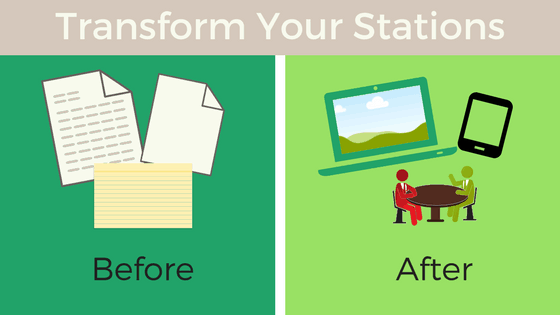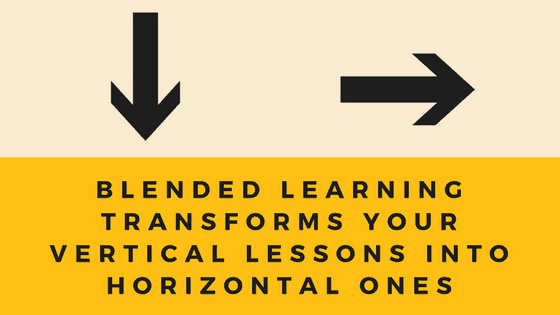Differentiation. It’s a commonly used term within education, but just because it’s a common term does not mean it’s easy to accomplish. Differentiation means altering instruction to meet the variety of needs students bring to the table during a class period. As teachers, we know we need to meet the needs of each of our students; however, when working with a classroom of 25 or more students, this is often a daunting task for even the most seasoned of educators.
I knew there had to be a way to make differentiation more approachable for teachers, so I started digging into various resources. I knew I was onto something when I first came across Catlin Tucker’s blog, focusing on incorporating blended learning into the lesson planning process. I devoured her blog posts and ordered two of her books. Inspired by what I was reading, I began to see how I could more easily manage differentiation within the classroom. Though she is a high school English teacher, her blog and books focus on blended learning for all grades and subjects.
What is Blended Learning?
Through my research, I discovered that blended learning elevates basic stations and centers by incorporating technology. Blended stations allow teachers to provide differentiation and also work with students on a platform that students might find more engaging. Good bye worksheets, hello collaboration and 21st century activities.
Planning for Blended Learning
Many teachers might find planning stations for blended learning daunting when they first begin. What made it click for me was when I realized that blended learning takes your vertical lesson and turns it into a horizontal lesson. What do I mean? If you think about your normal lesson, your plans run vertically. Your 1st task is followed by your 2nd then the 3rd task, etc. With stations, you can take your vertical lessons and simply run them horizontally so that they are all happening at the same time throughout the room.
Enter Differentiation
So where does the differentiation come into play? The great thing about blended learning is that you can have a teacher-led station in the mix of independent stations and collaborative stations. So this enables teachers to have small-group instruction and work on whatever standards those 4 or 5 students might be struggling with. Upon the next station rotation, the next group of students might get an entirely different experience at the teacher-led station based on what their needs might be. With strategic grouping on the teacher’s part, this is a huge benefit to blended learning lessons.
For example, if a teacher gives a mini-assessment and realizes that students 1-4 need help with R.L.10.4 but students 5-8 need help with R.L.10.2, then the teacher can strategically group those students together. At the teacher-led station, he/she can have resources ready to help each rotating group based off the data the teacher received from an assessment.
A blended learning station could be a collaborative station. For example, if students have read an article, they can work together on a shared google doc to analyze the claims the author makes within the text. But a blended learning station could also be an independent station, where students could complete an online assessment or view a pre-selected TED Talk video providing background knowledge for the current unit.
Truly, there is no right or wrong way to go about setting up blended learning stations. Stations can run from start to finish during one class period, or can run the span of several days. Also, contrary to what many believe, stations do not need to happen daily. Many teachers I know opt to use them to introduce a new unit or at the culmination of a unit. That’s the beauty of blended learning–you make it work for you and your students. With that said, the important part of stations is the pre-work. Yes, it may be a lot of planning up front, but the benefit is a classroom full of engaged students. When a student has to be up and moving every 20 minutes or so, it’s much more difficult to sit in the back of the room and disengage.
Not One but TWO Digital Tech Tools to Help Facilitate Blended Learning
Here are two free digital tools to try if you are interested in trying blended learning: Actively Learn and EdPuzzle. The Actively Learn site will let you upload an article that you want students to explore and then you can insert standards-aligned questions for students to answer as they read. Actively Learn also helps teach students annotation skills. EdPuzzle is a similar tool, but it uses videos. You can upload any YouTube or TED Talk clip and then break it up at strategic points by inserting multiple choice questions or discussion questions. In order to progress in the video, students must answer the question. Both of these tools are great to try out in blended learning because they allow you to get immediate feedback on how your students are understanding the video and/or article while allowing you to focus on the students at your teacher-led station.

I encourage you to give blended learning a try. Jump in with both feet and you and your students will fall in love with the process. Blended learning offers so much more than simply rotating around the room for students. It enables you to meet the needs of every one of your students with strategic planning for differentiation. Not only that, but blended learning also allows you to cultivate those all important teacher/student bonds from running your smaller teacher-led stations. And finally, it allows you to incorporate a tech element into your lessons, thereby increasing student engagement; another bonus is that, with only one tech station, you only need four laptops instead of a class set of 25! Grab a pen and some paper and start planning. Your students will thank you!



















Check out http://www.teacherstack.com if you are interested in using technology to help manage and run your station rotations!
I’ve started to incorporate station rotation into my lesson plans more and more. Like the article says, however, there is lot of work up front. Each time I use it though I am pleased to see how engaged the students are AND seem to be enjoying the class. Most really enjoy collaborative work – there are some who do not but they are the minority. I use it to incorporate all modes of language – reading writing, listening & speaking. I also try to incorporate activities which appeal to different types of learning – i.e.music, drawing, acting. I wish I had more time!
Wow! That sounds fantastic. I am inspired by your comment and after reading the article I think I am going to give it a try.
What caught my attention was your mention of the 4 aspects of language. Are you teaching a second language?
Blended learning is the most amazing practice in the world. I simply love it!